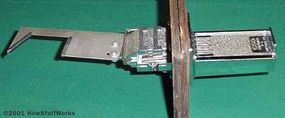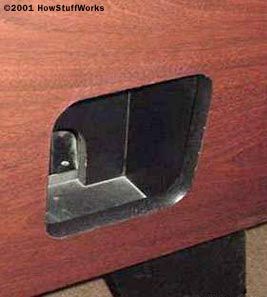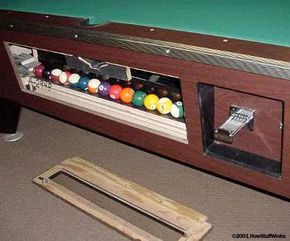The Path of Least Resistance
If you look inside a commercial table, there is a system of chutes that connect to the table's six pockets. Each chute is angled slightly downward from the pocket to the ball return. When a ball falls into that pocket, gravity causes it to roll along the guide until it reaches the ball return.
A pocketed ball is sent to a collection chamber where the balls line up single-file in a trough. These numbered balls remain locked in the chamber, which you can see behind a piece of Plexiglas, until someone wants to play a game and inserts some coins. By placing coins in a slot and pushing the coin arm in, you trip a lever that allows the balls to roll out of the trough into a large open access area at the foot end of the table.
Advertisement

Cue Balls
If a player accidentally pockets the cue ball (an act known as a scratch), the cue ball needs to come back out from the access area at the foot of the table. For the most part, coin-operated tables use two types of cue balls that can be easily separated:
- An oversized ball that is separated by a radius gauging device.
- A magnetic cue ball that triggers a magnetic detector.
The oversized ball is approximately 2-3/8 inches (6 cm) in diameter, which is about one-eighth of an inch (2 mm) larger than a normal ball. This slight difference in size allows the cue ball to be separated before it gets to the storage compartment. The smaller numbered balls are able to pass through a gauging mechanism, while the larger cue ball is directed through a second chute, where it falls out into an opening on the side of the table.
For players who dislike using the slightly larger cue ball, there are also coin-operated machines that can use a magnetic ball, in which a magnet is built into the core of the cue ball. Magnetic cue balls that go into a pocket are separated from numbered balls by a magnetic detector. As the magnetic ball passes this detector, the magnet triggers a deflecting device that separates the cue ball and, again, sends it into the opening on the side of the table.

Both the oversized and magnetic cue balls can be used interchangeably on most of today's coin-operated tables, but each has its shortcomings. If you are a beginning pool player the larger ball might not affect your play, but it can disrupt the play of some advanced players who are used to playing with the normal 2 1/4-inch diameter (5.7cm) cue ball. Likewise, some players will notice a difference in the properties of a magnetic ball, which sometimes lacks a true roll. Also, because the magnetic ball has the magnetic material inserted into it, it has a greater tendency to shatter if dropped on a hard surface.
Whether the table uses drop pockets or an automatic ball return, the components on top of the table are the same.
